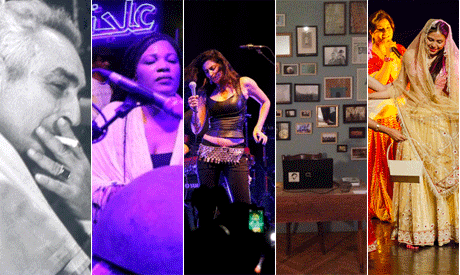
From left to right: AUC Cinema Conference including commemoration of Tawfiq Saleh, 3alganoob festival, Yasmine Hemdan at D-CAF, Medrar Studio Hopping, India by the Nile.
India by the Nile festival
For millennia, India has developed an astounding variety of cultures, samples of which are brought to Egypt for the annual India by the Nile festival. Taking place between 1 and 20 April, the second edition of India by the Nile presented a plethora of performing arts, music, films and exhibitions in Cairo, while also expanding to Alexandria and Hurghada. The festival is characterised by high-quality events showcasing a multitude of Indian arts, topped with fascinating meetings with top figures from the country’s artistic and intellectual circles.
Teamwork, a company organising the festival, also made sure to strengthen and initiate bonds between the two countries and build artistic bridges. Among many great activities, this year included Bollywood Love Story, a musical that saw 25 Indian artists on stage, Kathak dance recital, folk music from Rajasthan, an exhibition of Indian political cartoons, sari exhibition, screenings of Bollywood movies and discussions with India’s renowned artists and intellectuals. Apart from the thematic choices, India by the Nile is known for impeccable logistics and brilliant organisation, which contributed to the festival’s success.

India by the Nile Festival (Photo: Bassam Al-Zoghby)
Medrar’s Studio Hopping Project
One of the most exciting exhibitions of the month was Medrar’s Studio Hopping. The nine-year old artist collective, Medrar for Contemporary Art, conceived of a project to bring the visual art audience closer to the artists. Eighteen contemporary Cairo-based artists were selected to participate in an exhibition at Medrar’s headquarters in Garden City. But the public got the chance to do more than merely visit the exhibition; the studios and workspaces of these 18 artists were open to the audience to visit during various time-slots. With a vision to spark a more open dialogue between artist and audience, this project created a platform for a more direct confrontation between the two parties, challenging the traditional relationships between artists and the public. In a quirky and inventive twist, visitors to the studios (a party of five at a time) were asked to bring a gift to the artists.
The participating artists were; Ahmed Badry, Ahmed Sabry, Ali Abdel-Mohsen, Ammar Abo Bakr, Amr El-Kafrawy, Dia Hamed, Ganzeer, Hala El-Koussy, Hamdy Reda, Hany Rashed, Hashem L. Kelesh, Kareem Osman, Khaled Hafez, Marwa El-Shazly, Mohamed Abla, Mohamed Taman, Sabah Naim, and Shayma Kamel.
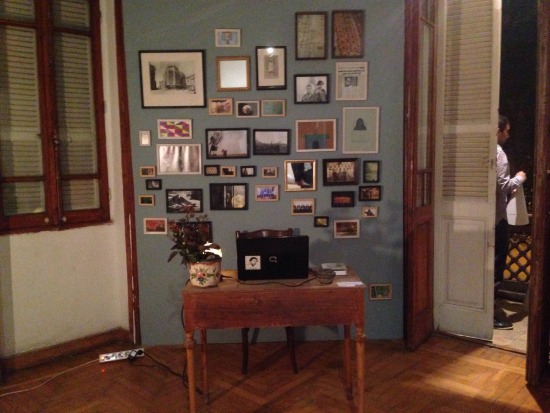
Work by Hala El Khousy Medrar's Studio Hopping project (Photo: Rowan El Shimi)
D-CAF Highlights
The third edition of the Downtown Contemporary Arts Festival (DCAF), which ran from 20 March to 11 April, was quite a dynamic – and at times dramatic – ordeal, with a mix of fascinating acts as well as problematic items on the agenda. Among the most successful elements was the sold-out concert by Lebanese musician Yasmine Hamdan at the Qasr Al-Nil Theatre, which headlined the festival's music program. The visual arts program, fully dedicated this year to contemporary multidisciplinary artist Hassan Khan, was also a unique experience. Spread out across four spaces in the Kodak Passageway that links Adly Street to Abdel-Khalek Tharwat Street in downtown Cairo, which were renovated by Cairo’s Laboratory for Urban Studies, Training and Environmental Research (CLUSTER), the exhibition was a valuable insight into this prolific artist's journey, featuring works by Khan from the onset of his art career in the 1990s up to the present day.
A four-day discussion series entitled "Is Art Important?" provided a worthy and constructive discursive element to the festival. Held at The GrEEK campus in downtown Cairo and curated by Jumana Al-Yasiri, the seminar included four panel discussions tackling the importance of art and its relationships to politics and education, along with the global perception of Middle Eastern art. A multidisciplinary performance titled La Voix est Libre(The Free Voices Festival) which began in 2005 in Paris' Bouffes du Nord Theatre was performed at the Falaki Theatre, the French Institute in Alexandria and Shehrazade Nightclub on D-CAF's closing night on 11 April, and was a thoroughly enjoyable fixture that captured the collaborative and entertaining nature of the festival. The music, dance, and circus performance featured both French and Egyptian artists.
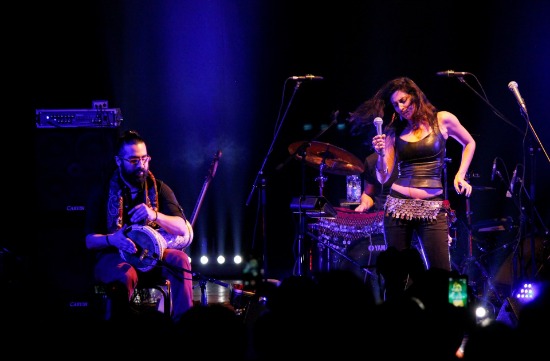
Yasmine Hemdan at D-CAF (Photo: Mostafa Abdel Aty)
3alganoob brings 18 acts to Egypt’s Marsa Alam for a unique beach music festival
Logistics of accommodation aside, the musical performances and artistic design and approach to 3alganoob makes it one of the month’s definite highlights. Running over Egyptian Easter weekend in the south of the country, almost 1,000 visitors enjoyed three days of music performed by Egypt and the region’s most diverse and inspired independent artists. The artists included acoustic musicians Massar Egbari, Abo & Sennary, Youssra El-Hawary, Tamer Abu Ghazala, Sabrine Darabuka, Safi, Asia Madani, Like Jelly, Bahia, El-Mazzikateya, reggae band Meshwar and party starters Soopar Lox. The line-up also featured various figures from the electronic music scene such as Fulltone, Nadah El-Shazly, Quit Together and Marice Louca, who gave a particularly inspired performance. Arabic trip-hop duo Egyptian Maryam Saleh and Lebanese icon Zeid Hemdan also performed with the two DJs, who played sets which one does not normally get from DJs Eskalob and White Nubian. Besides the high energy performances, the stage’s curators – members of Like Jelly band Youssef Atwan and Muhammed El-Quessny – managed to bring together a highly skilled team of technicians who made sure the sound and lights were up to high standards. Attention was also given to stage design by Marsa Alam local Mostafa Abulmajed, known as Gezazy. Visual artist Kareem Osman, along with Dia Hamed, built a cloth pyramid on top of a small ditch in the middle of the audience area which displayed live visuals throughout the festival and were synced to the musical performances.
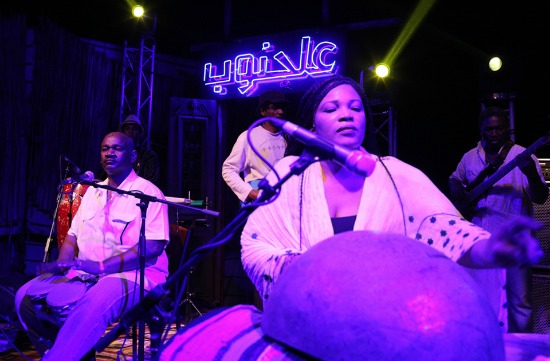
Asia Madani performs at 3alganoob (Photo: Mohamed Medhat)
'Post-2011 Cinema in Egypt' conference
Between 24 and 27 April, the American University in Cairo hosted a stimulating series of panel discussions tackling issues of film education, the film industry and criticism as part of its 'Post-2011 Cinema in Egypt' conference. On the evening of Thursday 24 April, a commemoration was held for late Egyptian filmmaker, Tawfiq Saleh, a pioneer of realism in Egyptian cinema who died on 18 August 2013. Discussions over the first three days of the conference examined the study of film in Egypt, its challenges and limitations and revolved around film criticism in mass media and academia. ‘Post-2011 Cinema in Egypt: Challenges and Opportunities’ offered a wealth of questions that are necessary for filmmakers, film educators and film enthusiasts alike to ponder during the country's current critical impasse.
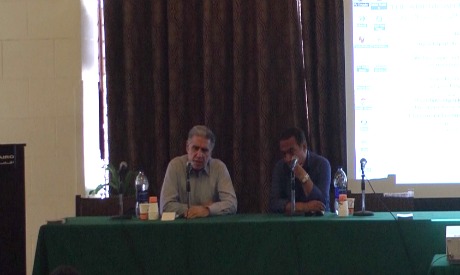
Producers Gaby Khoury and Mohamed El Adl
Short link: